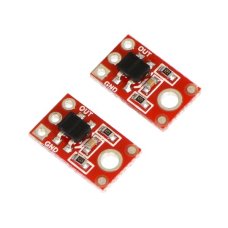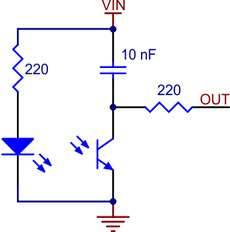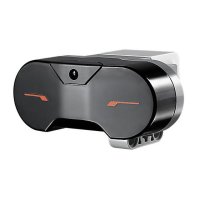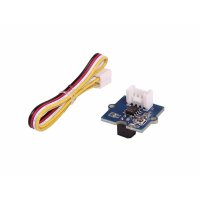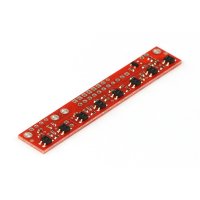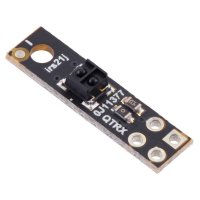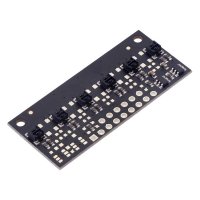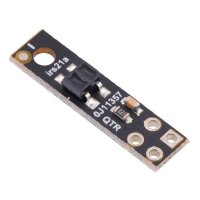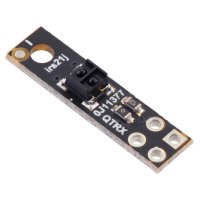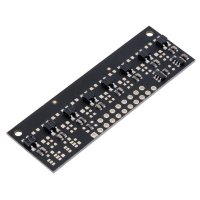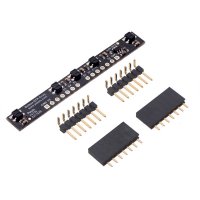The Pololu QTR-1RC reflectance sensor carries a single infrared (IR) LED and phototransistor pair. To use the sensor, you must first charge the output node by applying a voltage to the OUT pin. You can then read the reflectance by withdrawing the externally supplied voltage and timing how long it takes the output voltage to decay due to the integrated phototransistor. Shorter decay time is an indication of greater reflection. This measurement approach has several advantages, especially when multiple units are used:
The LED current-limiting resistor is set to deliver approximately 17 mA to the LED when VIN is 5 V. The current requirement can be met by some microcontroller I/O lines, allowing the sensor to be powered up and down through an I/O line to conserve power.
This sensor was designed to be used with the board parallel to the surface being sensed. Because of its small size, multiple units can easily be arranged to fit various applications such as line sensing and proximity/edge detection.
For a line sensor with eight of these units arranged in a row, please see the QTR-8RC reflectance sensor array; for a similar array of three slightly different sensor components, see the QTR-3RC. For a similar, smaller sensor with longer range, and intended for use with the board perpendicular to the surface, please see the QTR-L-1RC reflectance sensor.
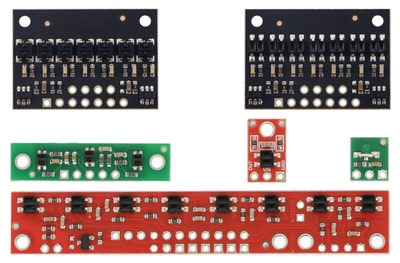 |
|
QTR sensor size comparison. Clockwise from top left: QTR-3RC, QTR-1RC, QTR-L-1RC, QTR-8RC. |
|---|
Specifications
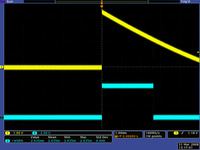 |
|
QTR-1RC output (yellow) when 1/8" above a black line and microcontroller timing of that output (blue). |
|---|
Interfacing the QTR-1RC output to a digital I/O line
Like the Parallax QTI, this sensor requires a digital I/O line capable of driving the output line high and then measuring the time for the output voltage to decay. The typical sequence for reading a sensor is:
 |
These steps can typically be executed in parallel on multiple I/O lines.
With a strong reflectance, the decay time can be as low as several dozen microseconds; with no reflectance, the decay time can be up to a few milliseconds. The exact time of the decay depends on your microcontroller’s I/O line characteristics. Meaningful results can be available within 1 ms in typical cases (i.e. when not trying to measure subtle differences in low-reflectance scenarios), allowing up to 1 kHz sampling.
Our Pololu AVR library provides functions that make it easy to use these sensors with our Orangutan robot controllers; please see the QTR Reflectance Sensors section of our library command reference for more information. We also have a Arduino library for these sensors.
Included components
This module has a single mounting hole intended for a #2 screw (not included); if this mounting hole is not needed, this portion of the PCB can be ground off to make the unit even smaller. Each pack of two reflectance sensors includes sets of straight male header strips and right-angle male header strips, which allow you to mount them in the orientation of your choice (note: the header pins might ship as 1×6 strips that you can break into two 1×3 pieces). You can also solder wires, such as ribbon cable, directly to the pads for the most compact installation.
|
|
How it works in detail
With only four components (or five, if you count the coupled IR LED and phototransistor separately), the operation of this sensor is relatively basic. The emitter side is just an IR LED with an appropriate current-limiting resistor. The light from the emitter leaves the sensor, reflects off a nearby surface, and returns to the detector.
The detector side is a resistor-capacitor (RC) circuit, where the resistance comes from the phototransistor and is a measure of the incident infrared light, and the decay time is proportional to the resistance. The first step of the sensor-reading process—driving the sensor output high—discharges the integrated 10 nF capacitor and puts both sides at the same voltage (VIN). Alternatively, you can think of this as “charging the output node”, and it is functionally equivalent to charging a capacitor with one side connected to ground. Once you are no longer supplying an external voltage to the output pin, the capacitor can slowly charge through the phototransistor, with the rate of charging being a function of the phototransistor’s resistance (which is in turn a function of the incident IR). As the capacitor charges, the voltage on the output side drops, eventually reaching zero when the capacitor is fully charged. Alternatively, you can think of this as “discharging the output node”, and it is functionally equivalent to discharging a capacitor with one side connected to ground.
The 220 Ω resistor on the OUT line serves to limit the current flow, making it possible for a microcontroller output to safely charge the output node prior to each reading. It has very little effect on the sensor output.
|
|
| Electrical Specifications | |
| Input Current | Supply Current: 17 mA |
| Maximum Operating Voltage | 5.0 V |
| Physical Attributes | |
| Dimensions | 0.3" x 0.5" x 0.1" |
| Additional Information | |
| Warranty | |
Pololu 2459 QTR-1RC Reflectance Sensor (2-Pack)
- Brand: Pololu
- Product Code: Pololu-QTR-1RC-Reflect-Sensor
- Reward Points: 4
- Availability: In Stock
- रo 416.00
-
रo 399.00
- Price in reward points: 416
-
- 35 or more रo 412.00
- 70 or more रo 409.00
- 170 or more रo 406.00
- 340 or more रo 402.00
Related Products
EV3 Infrared Sensor
The digital EV3 Infrared Seeking Sensor detects proximity to the robot and reads signals emitted by ..
रo 4,425.00
Grove - Infrared Reflective Sensor v1.2
Grove - Infrared Reflective Sensor v1.2 can be used for detection of proximity and color of objects...
रo 521.00
Pololu 961 QTR-8RC Reflectance Sensor Array
This sensor module has 8 IR LED/phototransistor pairs mounted on a 0.375" pitch, making it a great d..
रo 802.00 रo 835.00
Pololu 4443/4343 QTRX-MD-03A Reflectance Sensor Array 3 - Channel 8mm Pitch
Description This array of IR LED/phototransistor pairs is great for precisely identifying change..
रo 470.00
Pololu 4446/4346 QTRX-MD-06A-06RC Reflectance Sensor Array 6 - Channel 8mm Pitch Low Current
Description This array of IR LED/phototransistor pairs is great for precisely identifying change..
रo 898.00
Pololu 4101/4201 QTR-HD-01RC-01A Reflectance Sensor 1-Channel 5mm Wide
Description This IR LED/phototransistor pair is great for precisely identifying changes in refle..
रo 191.00
Pololu 4501/4601/4541/4641 QTRXL-HD-01A-01RC Reflectance Sensor 1-Channel
This IR LED/phototransistor pair is great for precisely identifying changes in reflectance (like lin..
रo 220.00 रo 229.00
Pololu 4148 QTR-MD-08RC Reflectance Sensor Array 8-Channel, 8mm Pitch, RC Output
This array of IR LED/phototransistor pairs is great for precisely identifying changes in reflectance..
रo 602.00 रo 628.00
Pololu 3577 5-Channel Reflectance Sensor Array for Balboa 32U4 Balancing Robot
The 5-Channel Reflectance Sensor Array for Balboa provides an easy way to add line sensing to the Ba..
रo 487.00
Tags: QTR, 1RC, Reflectance, Sensor

